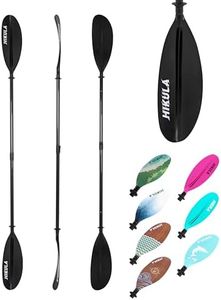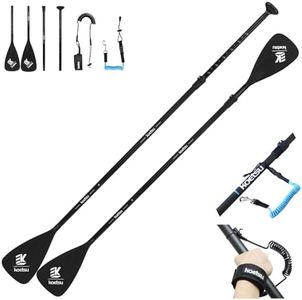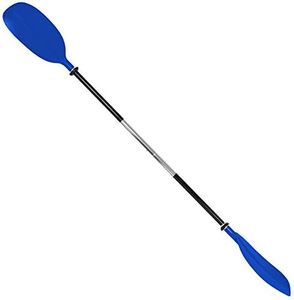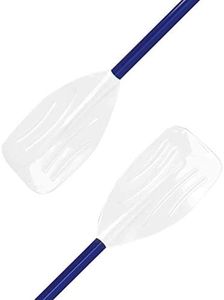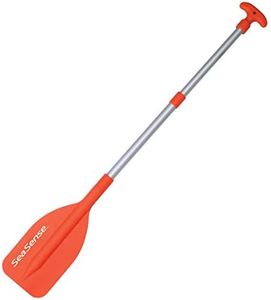We Use CookiesWe use cookies to enhance the security, performance,
functionality and for analytical and promotional activities. By continuing to browse this site you
are agreeing to our privacy policy
10 Best Kayak Paddles
From leading brands and best sellers available on the web.Buying Guide for the Best Kayak Paddles
Choosing the right kayak paddle is important because it directly affects your comfort, efficiency, and enjoyment on the water. The paddle acts as the connection between you and your kayak, so a well-chosen paddle makes paddling easier, reduces fatigue, and matches your strength, style, and the environment you’ll be kayaking in. Before you start shopping, think about where you plan to paddle most (lakes, rivers, sea), the type of kayaking you’re doing (recreational, touring, fishing, whitewater), and your own size and strength. Understanding the basic factors makes the selection process much simpler and ensures you end up with a paddle that helps you have the best possible experience.LengthPaddle length is the measurement from tip to tip and is crucial for comfortable and efficient paddling. If a paddle is too short, you might hit your hands on the kayak’s sides; if it’s too long, you’ll waste energy on each stroke. Paddle length is mainly influenced by your height and the width of your kayak. Generally, taller people and wider kayaks need longer paddles. Paddle lengths fall into short (ideal for whitewater and narrow kayaks or smaller paddlers), medium (good for average-sized paddlers in typical recreational kayaks), and long (best for taller people or wider/touring kayaks). To pick the right length, consider your height and the width of your kayak together. Most manufacturers offer sizing guides to help match you to the correct paddle length based on these details.
Blade Shape and SizeThe blade shape and size determine how the paddle interacts with water, affecting efficiency and speed. Larger and wider blades give you more power per stroke but can feel heavier or more tiring, while narrower or smaller blades are easier on your arms and better for a relaxed or steady paddling style. High-angle blades (shorter and wider) are suited for aggressive, fast paddling, like in whitewater or racing, while low-angle blades (longer and narrower) are ideal for casual touring or long distances, letting you paddle at an easy rhythm. Choose a blade that matches your paddling style: larger/high-angle for more power and sport, smaller/low-angle for endurance or recreational use.
MaterialsPaddle materials affect both the weight and durability of your paddle. Common materials are plastic, aluminum, fiberglass, and carbon fiber. Heavier materials like plastic and aluminum are affordable and tough, suitable for beginners or rougher use, but they can cause fatigue over time. Fiberglass offers a balance—it’s lighter and more efficient, making it great for frequent paddlers. Carbon fiber is the lightest and usually most expensive, reducing arm fatigue and maximizing performance, perfect for long trips or regular kayakers. Pick your material based on how often and how energetically you’ll use the paddle; lighter materials are better for longer or more frequent outings.
Shaft Type and ShapeShafts can be straight or bent and in one or two (sometimes four) pieces. Bent shafts have slight curves to improve grip angles, reducing strain on your wrists, ideal for those paddling long distances or with joint discomfort. Straight shafts are simple, lightweight, and suit most users for general paddling. You’ll also find adjustable or sectional shafts, which are convenient for travel or sharing among users of different sizes. The texture (oval or round) can influence handling, with oval offering a natural, secure grip. Your best bet is to try both styles if you can to see what feels more comfortable, especially if you expect to spend hours paddling.
Feathering (Blade Offset)Feathering refers to the angle between the two blades. Some paddles let you set the blades at an angle (feathered), while others have both blades in line with each other (unfeathered). Feathered paddles can reduce wind resistance on the blade that’s out of the water, making them effective in breezy conditions and popular with those paddling faster or in open water. Adjustable feathering is increasingly common, letting you choose your preference. Beginners might start with unfeathered paddles for simplicity; as you gain experience, experiment with feathering to see if it increases your efficiency.
WeightPaddle weight plays a big role in how tired you’ll feel after a day of kayaking. Lighter paddles are easier to handle and reduce the strain on your arms and shoulders, improving comfort, especially over long trips. Heavier paddles might be fine for short outings or casual use, but for tours or regular kayaking, lighter is always better if possible. When considering the weight, make sure it doesn’t come at the cost of durability for your particular type of paddling.


